 Weird Stuff
Weird Stuff  Weird Stuff
Weird Stuff  Our World
Our World 10 Ways Your Christmas Tree Is More Lit Than You Think
 Movies and TV
Movies and TV The 10 Coolest Stars to Set Sail on The Love Boat
 History
History 10 Things You Didn’t Know About the American National Anthem
 Technology
Technology Top 10 Everyday Tech Buzzwords That Hide a Darker Past
 Humans
Humans 10 Everyday Human Behaviors That Are Actually Survival Instincts
 Animals
Animals 10 Animals That Humiliated and Harmed Historical Leaders
 History
History 10 Most Influential Protests in Modern History
 Creepy
Creepy 10 More Representations of Death from Myth, Legend, and Folktale
 Technology
Technology 10 Scientific Breakthroughs of 2025 That’ll Change Everything
 Weird Stuff
Weird Stuff Ten Bizarre Facts About The Doge Meme
 Our World
Our World 10 Ways Your Christmas Tree Is More Lit Than You Think
 Movies and TV
Movies and TV The 10 Coolest Stars to Set Sail on The Love Boat
Who's Behind Listverse?

Jamie Frater
Head Editor
Jamie founded Listverse due to an insatiable desire to share fascinating, obscure, and bizarre facts. He has been a guest speaker on numerous national radio and television stations and is a five time published author.
More About Us History
History 10 Things You Didn’t Know About the American National Anthem
 Technology
Technology Top 10 Everyday Tech Buzzwords That Hide a Darker Past
 Humans
Humans 10 Everyday Human Behaviors That Are Actually Survival Instincts
 Animals
Animals 10 Animals That Humiliated and Harmed Historical Leaders
 History
History 10 Most Influential Protests in Modern History
 Creepy
Creepy 10 More Representations of Death from Myth, Legend, and Folktale
 Technology
Technology 10 Scientific Breakthroughs of 2025 That’ll Change Everything
10 Great Works Of Art Destroyed By Vandals
Supposedly, it is the job of art to provoke a reaction in its audience. Unfortunately, some people have a more extreme response than others. For example, people with Stendhal syndrome may experience anxiety, disorientation, nausea, hallucinations, and temporary madness brought on by exposure to art.
Sufferers feel overwhelmed in the presence of what they perceive to be immense beauty. Doctors at a hospital in Florence regularly treat patients who have become overwhelmed when looking at Michelangelo’s statue David.
However, it is not just Stendhal syndrome sufferers who are affected by art. Many frustrated artists and political activists have reacted to art works, too, mostly by trying to destroy them.
Here, we look at 10 famous artworks that have been attacked by vandals.
10 Rokeby Venus
Diego Velazquez
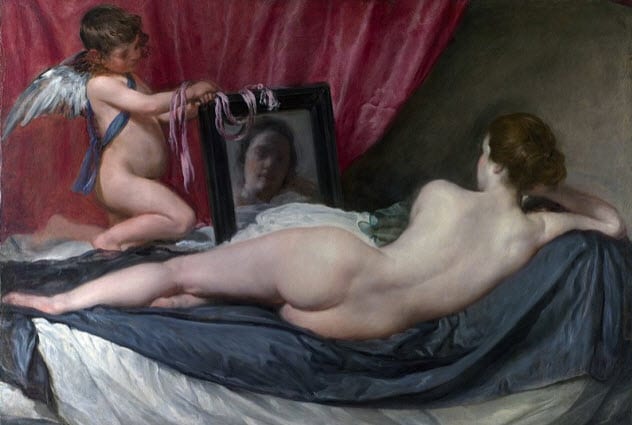
In 1914, the Rokeby Venus was slashed by the suffragette Mary Richardson as it hung in the National Gallery in London. The painting suffered at least five gashes made with a meat cleaver. Richardson was protesting the arrest of Emmeline Pankhurst and was soon nicknamed “Slasher Mary” by the press.
Richardson maintained that she had carried out the protest not just to raise awareness of Pankhurst’s arrest but also to object to “the way men visitors gaped at [the painting] all day long.” The Rokeby Venus featured a naked woman with her back to the painter.
Her bottom is especially prominent and is said to have a “3-D quality” that makes you want to touch it. The woman in the painting looks back at the viewer from a mirror as though she knows she is being watched, which gives the viewer the feeling of being caught in the act of being a voyeur.
The painting has since been expertly restored, and only a trace of the damage can now be seen.[1]
9 The Fall Of The Damned
Peter Paul Rubens
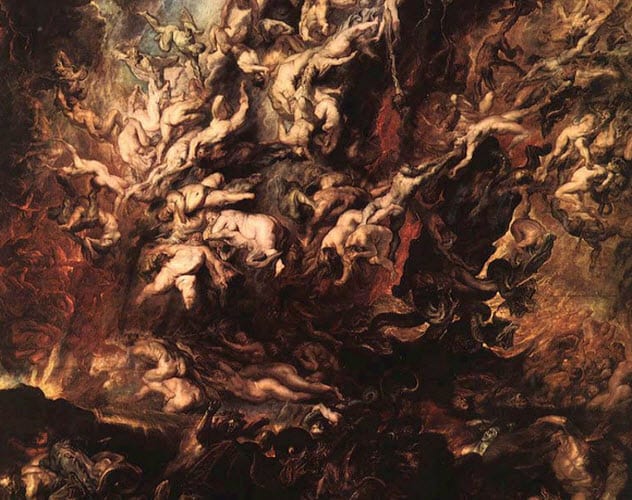
The Fall of the Damned was painted by Rubens in 1620. It depicts the fall of the rebel angels from Heaven into Hell. It is an enormous painting, measuring over 2.9 meters (9 ft) by 2.2 meters (7 ft), with large numbers of mortals and rebel angels in varying states of undress falling through the sky into the fiery pit below.
In 1959, the painting was attacked with acid. The vandal claimed that he had not destroyed the artwork directly because the acid “relieves one from the work of destruction” (which is a little like saying a gun relieves one from the work of shooting someone in the head).
It is not known why he chose to destroy The Fall Of The Damned, but restorers have been able to work from Rubens’s original sketches to try to recreate the piece. However, despite concerted restoration attempts, the acid melted through the paint and has caused permanent damage to parts of the artwork.[2]
8 Mona Lisa
Leonardo Da Vinci
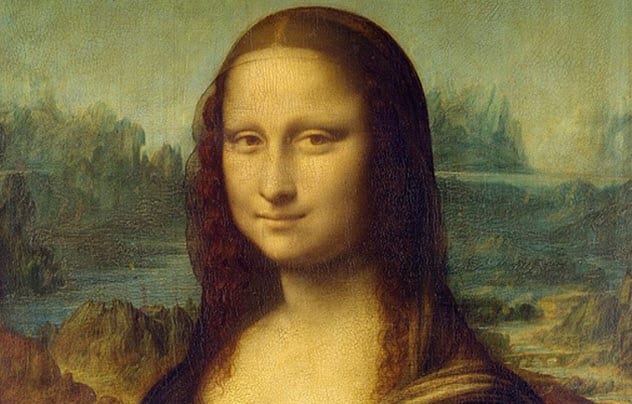
The Mona Lisa has been targeted by vandals numerous times. It was damaged twice in 1956—once when a vandal threw acid at the painting and again when someone hurled a rock at it.[3]
Most recently, a Russian woman who had just been denied French nationality threw a cup at the painting. However, authorities at the Louvre had obviously learned from past experiences. The most expensive painting in the world is protected by bulletproof glass. The cup, which was empty, broke harmlessly against the glass.
7 Ivan The Terrible And His Son
Ilya Repin
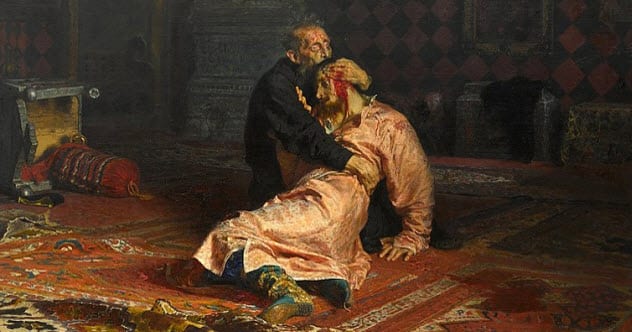
Ivan The Terrible And His Son is one of Russia’s most famous and controversial paintings. It depicts the infamous tsar cradling his dying son in his arms with the tsar’s grief and horror clearly visible on his face. Possibly, the horror is because Ivan killed his own son out of paranoia.
In May 2018, the artwork was attacked by a man who went to view the painting after drinking a fair amount of vodka. He picked up one of the metal poles used to hold the barrier ropes. Then he charged at the painting with the pole, smashing through the security glass and ripping the canvas.
Luckily, the pole did not go through the main part of the picture. It is not clear why the vandal chose this painting to destroy. It may have been because this artwork has long been the cause of controversy in Russia, with many nationalists disputing the accepted interpretation about Tsar Ivan IV Vasilyevich.[4]
After his arrest, the suspect reportedly told police, “I wanted to leave, but then . . . drank 100 grams of vodka and became overwhelmed by something.” Well, that will do it.
It is not the first time that the picture has been attacked. The artist himself restored the painting after it was slashed in 1913. Reports from the gallery say that the artwork can be restored but it will take years.
6 La Berceuse
Vincent Van Gogh
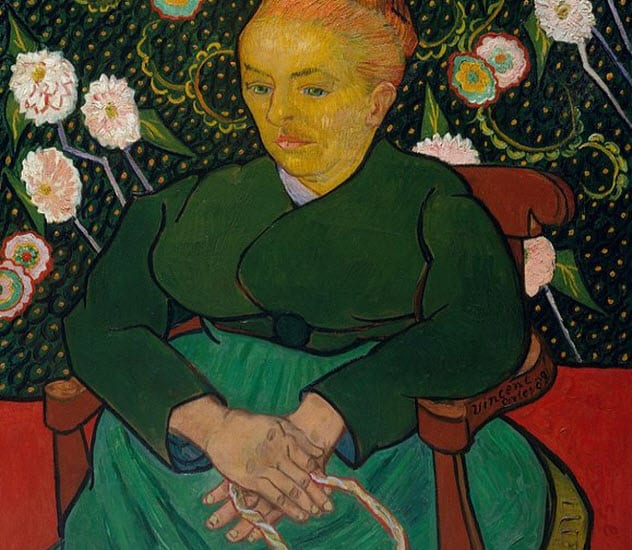
Vincent van Gogh began the painting of La Berceuse just days before he famously cut off his own ear. He completed the picture after his return from the hospital.
The painting features a woman sitting in a rocking chair. She is holding a rope which rocks an unseen cradle. Van Gogh is said to have obsessed about the painting while detained in the hospital. He even sang lullabies to the off-canvas child while he was delirious.
Van Gogh created five versions of the painting. While one of them was on loan to Amsterdam’s Municipal Museum, it was slashed three times by a man claiming to be an artist. It is not known why he chose to damage the picture.[5]
It is not the first time that van Gogh’s work has been targeted by frustrated artists. In 1978 in the Van Gogh Museum, a visitor slashed a huge “X” across the face of van Gogh’s famous Self Portrait with Grey Felt Hat. The painting was restored, but the damage can still be seen, especially when viewed from the side.
Like van Gogh, the vandal was deemed to be insane and sent to a mental institution.
5 Argenteuil Basin With A Single Sailboat
Claude Monet
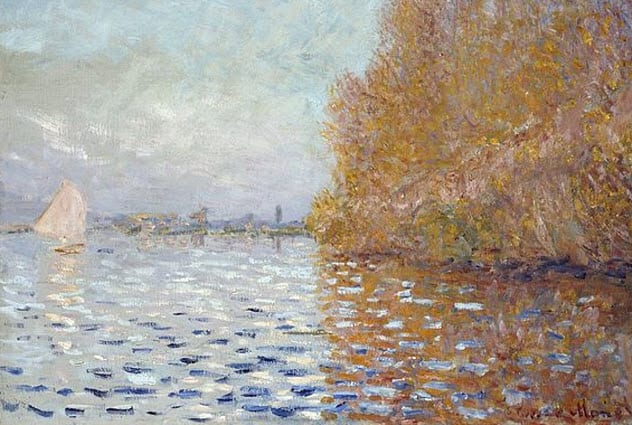
In 2012, Andrew Shannon visited the National Gallery in Ireland along with hundreds of other people. However, unlike the other visitors, he punched the Monet masterpiece Argenteuil Basin with a Single Sailboat. The painting had been created in 1874 and showed a sailboat on a lake near Paris. Monet had lived in the area, where he converted a boat into a floating studio.[6]
Shannon was caught on CCTV running directly at the picture and slamming his fist through it. Valued at $10 million, the painting was badly damaged. He maintained that he punched it to “get back at the state,” though he was not clear about how this helped.
The painting took 18 months to restore.
Shannon was a frustrated artist. It is possible that Monet may have understood. After all, in 1908, Monet destroyed his own paintings—just before they were due to be exhibited—because he was unsatisfied with them.
4 The Night Watch
Rembrandt
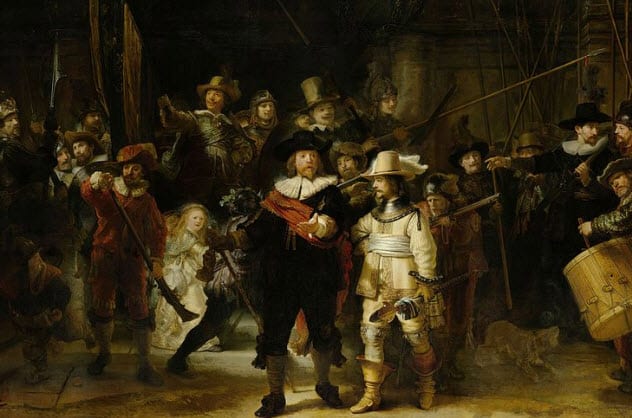
Rembrandt’s The Night Watch was created in 1642. It depicted soldiers beginning the night watch while overseen by their commanding officers. The painting was one of the finest examples of Rembrandt’s use of light and shade. In 1975, the priceless artwork was hanging in a museum in Amsterdam when a man entered with a bread knife and began slashing at the painting.
He made more than a dozen gashes, mostly to the lower half of the huge painting. He kept on slashing with one hand while fending off a security guard with the other. A piece of canvas in the center of the picture was completely ripped off. The assailant was said to have told witnesses that he “did it for the Lord.” The man, who had a history of mental illness, was eventually subdued.
Unusually, the museum decided that restoration will be carried out in the public gallery where the painting normally hangs. Visitors will be given the opportunity to watch the restoration process as it happens. Work is due to begin in July 2019, 350 years after the painter’s death.[7]
3 Guernica
Pablo Picasso
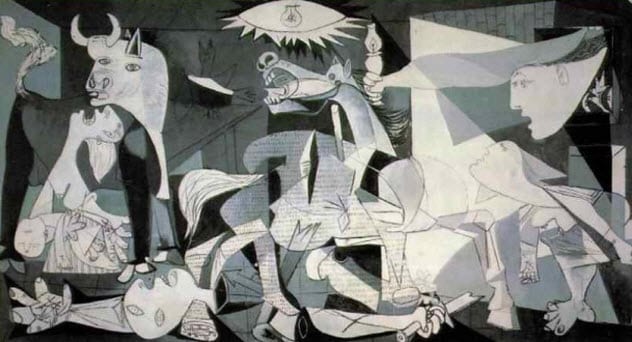
Pablo Picasso’s Guernica, which depicts the Nazi bombing of the civilian town of Guernica during the Spanish Civil War, is considered to be a modern masterpiece. In 1974, the painting was on loan to the Museum of Modern Art from Picasso himself when Tony Shafrazi spray-painted the words “Kill Lies All” in letters 0.3 meters (1 ft) high across the picture.
The vandal told horrified bystanders his name, even spelling it out for them in case they cared to contact the press. When asked why he had damaged the painting, he apparently replied, “I’m an artist, and I wanted to tell the truth.”
Museum staff immediately sealed off the room while restoration experts removed the red spray paint. The graffiti was eliminated within an hour without causing lasting damage. The varnish on the painting had acted as a shield against the spray paint, which could then be wiped away.
It was later stated that Shafrazi was reacting to the pardoning of a US army officer for the 1968 My Lai massacre, attempting to give “a new voice” to the painting, or both.[8]
2 The Virgin And Child With St. Anne And St. John The Baptist
Leonardo Da Vinci

Drawn sometime around 1510, The Virgin And Child With St. Anne And St. John The Baptist (aka The Burlington House Cartoon) shows St. Anne with the Virgin Mary as well as Christ and John the Baptist as children. It is believed to be the preliminary sketch for a painting that does not exist. The picture is drawn in charcoal and chalk and, as such, is incredibly fragile.
In 1987, the drawing was damaged when Robert Cambridge blasted it with a sawed-off shotgun from 2.1 meters (7 ft) away. He told police that he wanted to show his disgust at “political, social, and economic conditions in Britain.”
Cambridge managed to enter the gallery with the shotgun concealed beneath his coat. The main force of the blast hit the protective glass over the drawing, but the center of impact tore a 15-centimeter (6 in) hole through the dress of the Virgin Mary. Cambridge was declared not guilty of vandalism by reason of insanity and was committed to a mental institution.
The painting, which was valued at $35 million at that time, was severely damaged. Restorers had to collect the tiny fragments of blasted paper and glue them back together, one by one, but most of the damage is now invisible.[9]
1 Girl With Balloon (aka Love Is In The Bin)
Banksy
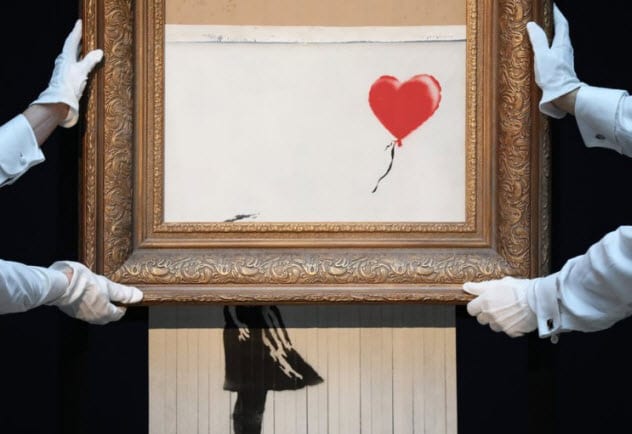
In 2004, the elusive graffiti artist Banksy created a painting he called Girl with Balloon. The painting was surrounded by an ornate and unusually heavy frame.
When the picture was sold in October 2018, the reason for the heavy frame became clear. The bottom contained a shredding machine. As the hammer went down on the approximately $1.3 million painting, someone flipped the switch.
Video later released by the artist appears to show that Banksy attended the auction. As people were applauding the sale, he pressed a remote control button, triggering the shredder. The painting dropped from the frame, and two-thirds of the picture was immediately destroyed.
However, according to the artist, the shredder malfunctioned. Instead of destroying the entire picture as intended, the shredder ground to a halt, leaving the painting dangling like very expensive fringe below the frame.
The new owner was not put off. She said that she was happy with the picture, now renamed Love is in the Bin. So she handed over her check and took it home.
No doubt with a bit of a red face, the spokesman for Sotheby’s said: “The new narrative is that Banksy did not destroy a work on its premises, he created one, adding value, not detracting. It is a different work to the one that appeared in the catalog, but nonetheless it is an intentional work of art, not a destroyed painting.”[10]
Ward Hazell is a writer who travels and an occasional travel writer.
Read more great stories about famous works of art on 10 Obscure Facts About Great Works Of Art and 10 Great Stories Behind Famous Works Of Art.








